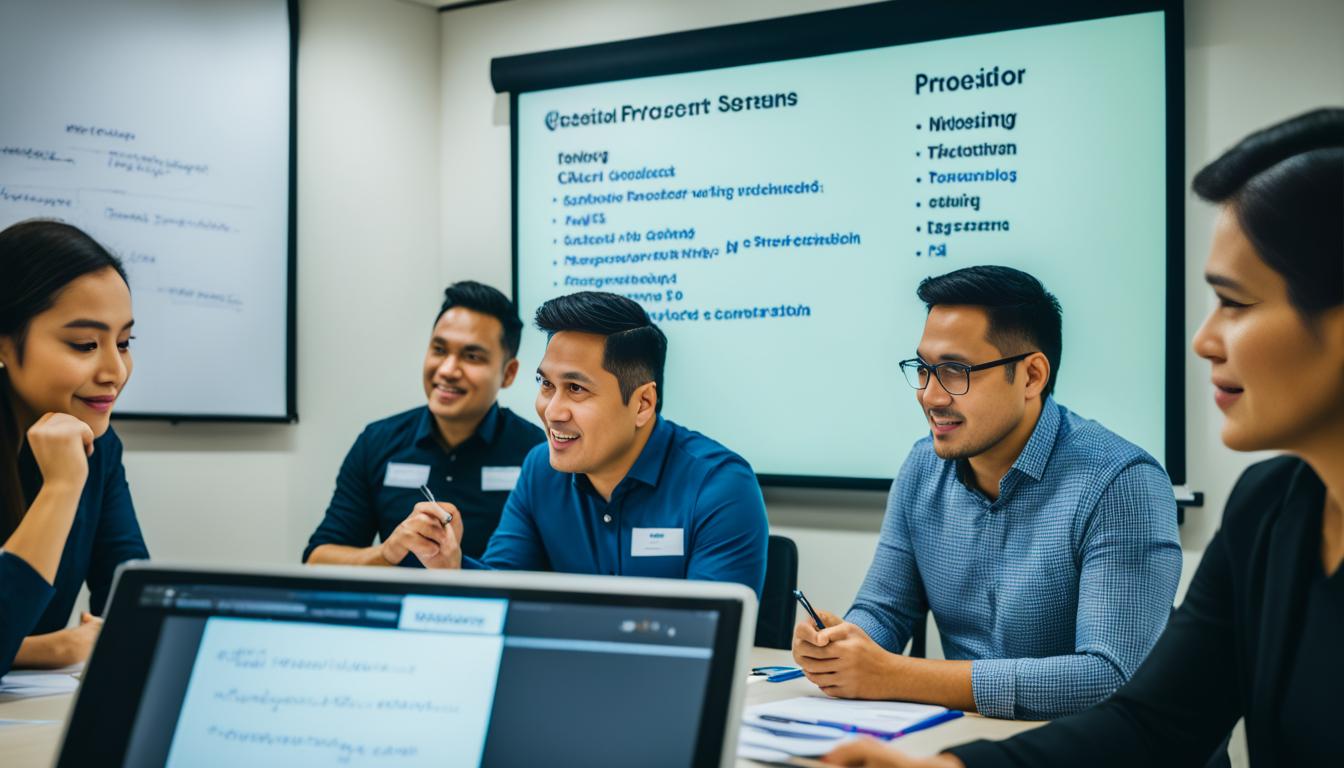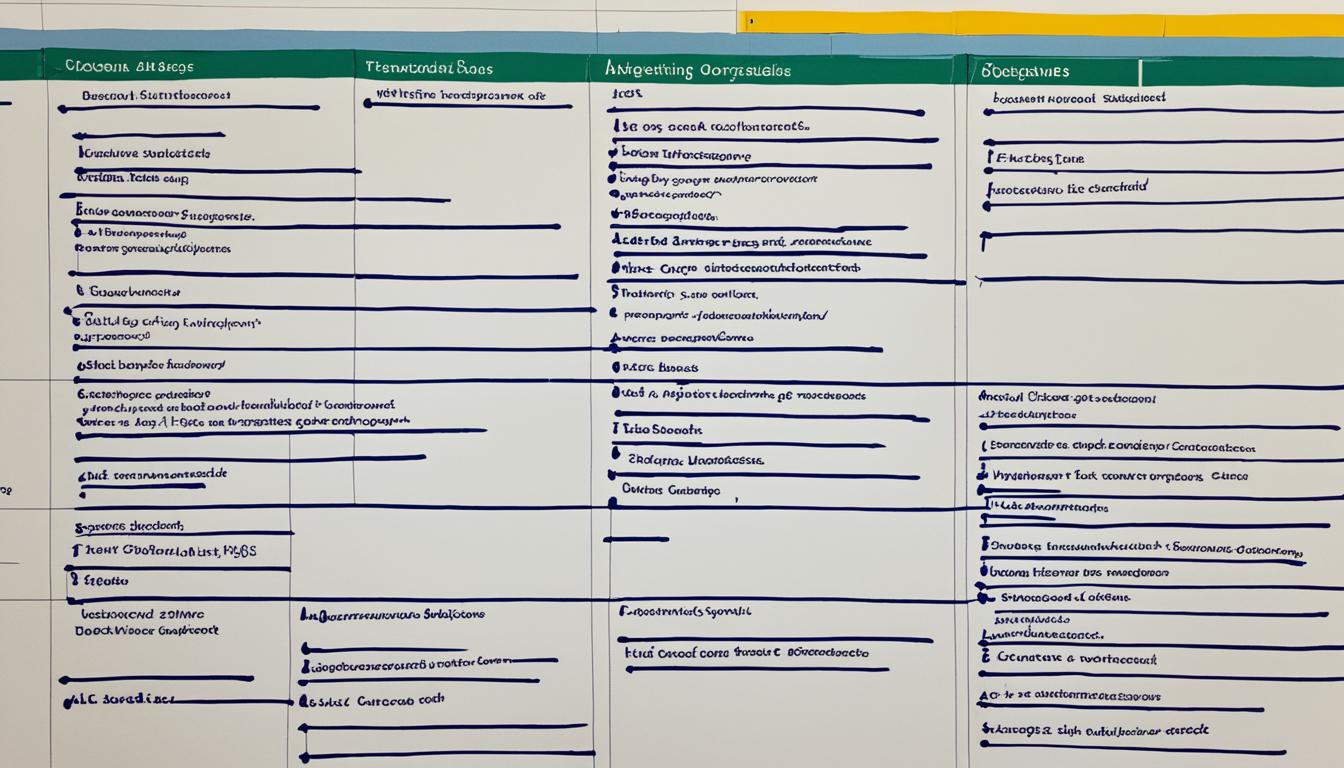Ever thought of making great meeting minutes? Want to boost your skill in documenting meetings? Making detailed meeting minutes is vital for clear talks, deciding, and tracking what gets done. It helps everyone stay on the same page.
This guide shows how to make meeting minutes step by step. You will learn about their role in businesses. We’ll talk about the duties of the person taking the notes and how to make sure the meeting goals are clear for everyone.
We’ll also give advice on getting ready, how to organize your notes, and how to polish them off. Plus, experts will share some tips too.
Key Takeaways:
- Creating accurate and effective minutes of the meeting is crucial for effective communication, decision-making, and accountability.
- Meeting minutes document discussions, decisions, and action items, and play a significant role in the business context.
- The minute taker has important responsibilities in capturing comprehensive meeting minutes.
- Defining the purpose of the meeting is essential for accurate documentation.
- Preparation, structuring, and formatting are key elements for creating organized and easily accessible meeting minutes.
Understanding the Role of Meeting Minutes in Business
Meeting minutes are key in keeping businesses running smoothly. They record talks, choices, and tasks set in meetings. This way, vital details get saved and shared with the people involved.
What are Meeting Minutes and Their Functionality?
They are official notes from a meeting, keeping a lasting account. Minutes show the main talk points, decisions, and what needs to happen next. Their roles range from documenting essential info to aiding in follow-ups and accountability.
- Documentation: They record critical points and agreements made.
- Communication: Minutes help remind everyone of meeting talk and choices.
- Accountability: They track who needs to follow through on what was agreed upon.
The Historical Significance of ‘Meeting Minutes’
Recording meetings has been around since ancient times. It started with the Roman Senate and the medieval English Parliament. Initially, minutes were just a record of what happened. Now, they’re essential in sharing info, keeping things clear, and making sound decisions in business.
Legal and Ethical Implications of Documenting Minutes
Writing minutes has both legal and ethical weight. In the eyes of the law, they’re proof of meeting outcomes and following rules. Good notes can help companies avoid legal troubles. Ethically, minutes ensure everyone is on the same page, thus promoting fairness and honesty. They also clear up any debates or confusion that could occur. In the end, clear, open, and detailed minutes build trust and effective operation in companies.
Identifying the Minute Taker: Roles and Responsibilities
To make sure meeting minutes are right, someone must take clear notes. The minute taker focuses on writing down what’s said, any decisions, and what needs to happen next. They don’t just jot down words; they craft a precise, easy-to-follow summary of the meeting.
Picking the right minute taker means finding someone who listens well, absorbs information fast, and knows how to pick out the main points. They must be organized and good with time to catch all the important stuff.
The minute taker also needs to understand the meeting’s topic. This helps them explain complex ideas in a simple way. Then, everyone can grasp what was discussed.
It’s vital to give the minute taker the tools they need to do their job well. They should have meeting documents, agendas, and templates at hand. With the right support, the process of taking minutes becomes smoother and the documents come out looking more professional and consistent.
By making sure a suitable minute taker knows what’s expected, organizations can get accurate and detailed meeting notes. These notes become a key reference for later.
The minute taker’s role goes beyond just taking notes; they are responsible for creating a clear and concise record of the meeting proceedings.
Defining the Meeting’s Purpose for Accurate Documentation
It’s key to clearly state a meeting’s objectives for it to succeed. This means laying out the meeting’s purpose and goals. Doing so makes sure everyone knows what to focus on and helps keep the meeting efficient and documented well.
Articulating the Meeting’s Objectives
It’s important to set goals before a meeting starts. These goals should be specific, can be measured, and aimed at a clear outcome. Setting clear objectives keeps everyone on track. It helps the meeting stay on point, making sure important topics and actions are recorded in the minutes.
Aligning Meeting Goals with Minute Content
When writing up the meeting minutes, ensure they tie back to the meeting’s goals. This way, the minutes give a clear, brief account of what was discussed, decided, and what actions to take. When the minute’s structure matches the meeting’s goals, it’s easier for people to understand and use the document.
Imagine a meeting where the aim is to sort out project timelines and tasks. In this case, the meeting minutes should clearly show what was decided on project deadlines and who’s in charge of what. This direct link between goals and minutes content helps people communicate and follow up after the meeting effectively.
By clearly establishing a meeting’s purpose and goals and reflecting them in the meeting minutes, organizations can ensure the discussion and decisions are well-documented. This clear approach supports clearness, responsibility, and better communication. Overall, this improves the meeting’s success and contribution to the organization.
How to Create Minutes of the Meeting: Best Practices for Preparation
Creating meeting minutes that are accurate and useful takes important steps. Prepare well and pay attention to details. This ensures your notes have all needed info and are good for future use.
- Review the agenda: Look over the agenda before the meeting. It helps you know what topics to focus on. This makes sure you get the important stuff in your notes.
- Gather necessary documents: Bring any documents or reports to the meeting that you might need. This lets you reference them correctly in your notes.
- Set up the note-taking environment: Choose a quiet, comfy spot for note-taking. Make sure you have everything you need, like a laptop or notepad, to take notes well.
- Organize and prioritize information: Listen closely during the meeting and write down key points, decisions, and tasks. Use clear headings and bullet points in your notes. This makes them easy to follow later on.
These prep steps lead to detailed and useful meeting minutes. They are a key resource for everyone involved.
Check out the image below to see the best practices for meeting minutes:
The Anatomy of Meeting Minutes: Essential Elements to Include
When you write meeting minutes, include key details for a full view of the meeting. Start with the date, time, and place. Add who was there and what was talked about. This makes your minutes clear, well-organized, and useful.
Logging Basic Meeting Details
Begin by noting the meeting’s basic info. This includes the date, time, and where it happened. These details give context for any future discussions or decisions made.
Listing Attendees and Keynote Speakers
Listing who came and spoke is very important. It shows who shared their thoughts and ideas. Also, it ensures everyone’s contributions are noted in the minutes. Clearly list their names and roles.
Outlining Agenda Items
Outline what was on the agenda. List the topics in the order they came up. This makes it easy for anyone reading the minutes to follow along. They can find what they’re interested in quickly.
Putting these elements in your minutes makes them a powerful tool. They help with keeping everyone on the same page. Plus, they’re handy for looking back on what was decided and why.
Utilizing Meeting Minutes Templates for Efficient Note-Taking
One key to taking good notes at meetings is to use templates. These templates have a set format. This format saves time and makes sure your notes are always consistent.
They let you focus on the meeting itself. You won’t have to worry about how your notes should look or be organized.
Meeting minutes templates are like a guide. They help you include all the important parts of the meeting. This includes things like the meeting date, who was there, what was discussed, and what decisions were made.
These templates also leave space for any extra notes or tasks that need to be done after the meeting.
Templates for meeting minutes come with a few perks:
- Time-saving: These templates mean you don’t start from zero each time. Just fill in the blanks. This makes things faster.
- Consistency: They help make sure every meeting’s notes look the same. This makes it easier for people to follow along later.
- Organization: Templates keep your notes neat. Everything is in its right place. So, reviewing or referencing them later is a breeze.
- Clarity: Using a template makes sure you don’t miss the main points. It keeps everyone clear on what needs to be done next.
Feel free to tweak the template. Make it work better for your meetings. Add or remove parts as you see fit.
Using templates improves how you take notes. It also makes sure you catch every important point. This way, all decisions and talks in the meeting are saved right.
‘Minutes’ vs. ‘Momentous’: Capturing the Essence, Not Every Second
The key to good meeting minutes is highlighting the main points and decisions. It’s about the essence, not every second. This approach makes sure we remember the important parts without getting lost in details. Meeting minutes act as a short version of the meeting, keeping key info in focus. This way, the document is clear, brief, and useful.
Below are some tips to help you get the most out of meeting minutes:
- Listen up: Tune in to key discussions and decisions. This helps you pick out what’s most vital for the minutes.
- Sum it up: Don’t write down every word. Just catch the essential discussions and outcomes. This gives a clear picture of what the meeting was about.
- Speak plainly: Use simple, clear words. Leave out the complex language. It helps everyone understand what was said.
- Actions matter: Make sure to note down what needs to happen next. This makes sure things actually get done after the meeting.
By focusing on what really matters in the meeting, you create valuable meeting minutes. It’s all about getting to the heart of the discussion, decisions, and goals. Remember, your goal is a short, focused record. Use these tips to highlight the important stuff. This way, your minutes truly reflect the meeting’s importance and what was achieved.
Meeting Notes Format: Structuring for Clarity and Future Reference
Creating a Cohesive Structure
To make meeting minutes easy to understand and useful, a clear format is key. It should be organized well, which helps readers find what they need quickly. A logical and consistent layout allows easier navigation through the notes.
Initially, separate your notes into sections or headings by main topics. This lets readers jump to the specific parts they want. Make sure the headings clearly match what’s in that section.
For each topic, keep the format the same. List main points, decisions, and tasks clearly using bullet points or numbers. Breaking up information this way helps readers keep track.
You might also use subheadings or indentations for more detailed organization. This improves the document’s flow and makes it visually cleaner. Always aim for clear and efficient language.
At the end, add a summary of the main points or takeaways. This quick reference helps readers understand the meeting’s important aspects without a deep dive into the details. It’s a great way to wrap up your notes.
Formatting for Easy Retrieval and Review
Formatting notes in a way that’s easy to find and review is vital. Using consistent styles improves how accessible and usable they are.
Here are some formatting tips:
- Pick a readable font and size.
- Use clear headings to separate topics.
- Add white space for better look and feel.
- Mark important parts with bold or italics.
- Tables or bullet points are great for lists.
Consistency is key for formatting. It helps readers quickly locate information.
By carefully structuring and formatting your notes, you turn them into a go-to resource. It becomes easy to understand, find, and use in the future.
Applying AI Technology to Enhance Minute Taking
AI technology is changing the way we do business, including how we take meeting notes. It makes the minute-taking process faster and more accurate. This approach boosts the quality of meeting records, offering several advantages.
AI’s best feature for minute taking is its ability to take notes by itself. This cuts down on the time it takes and eliminates mistakes that come with manual note-taking. With AI, everything said in a meeting can be written down as it happens, ensuring nothing important is left out.
Furthermore, AI doesn’t just write out what’s said; it can also summarize it. This means meeting participants don’t have to read through long transcripts to find the main points or action items. They can quickly look at summarized notes to make decisions fast, leading to better use of time and increased efficiency.
AI also understands the feelings and topics talked about in a meeting. It can tell you what was happy or sad, what the key topics were, and any notable trends. These deep insights turn meeting notes into powerful tools for making future decisions based on solid data.
This technological leap doesn’t stop there. It brings better accuracy, time saving, higher productivity, and more teamwork. And with AI always advancing, we can look forward to more features designed to make taking minutes even better.
In the end, AI is completely changing how we take meeting notes. It’s automating the old manual processes, making summaries, and giving us useful details. This means organizations can run their meetings better and make smarter choices for their future success.
Minute Taking Best Practices: During and Post-Meeting Strategies
To get accurate and useful meeting minutes, follow some key steps before and after the meeting. This includes making sure you note down all important tasks and choices, and then quickly edit and send out those minutes.
Recording Action Items and Decisions
The minute taker’s main job is to make sure they get all the to-dos and choices right. They need to:
- Active listening: Pay close attention. Make sure you grasp all important tasks and choices.
- Be concise: Focus on the key tasks, who’s doing them, and when. Keep it clear to avoid mix-ups.
- Assign ownership: Make crystal clear who is in charge of each task. This boosts responsibility.
- Seek clarification: Don’t shy away from questions if something is unclear. Ask then and there, or right after the meeting.
Editing and Sharing Meeting Minutes Expeditiously
It’s critical to check and fix the meeting notes soon after the meeting. This makes sure they cover everything discussed rightly. Here’s how to efficiently edit and send out the minutes:
- Review for accuracy: Carefully check for errors. Make sure all details are spot on.
- Check for clarity and consistency: Your minute notes should be clear and easy to follow. Stick to a clear format and language throughout.
- Prioritize confidentiality: Keep private info safe when sharing the notes.
- Share promptly: Try to share the minutes right after the meeting. This helps everyone act on them quickly.
By sticking to these guides, your note-taking skills will improve. This way, everyone can rely on your minutes as a solid record of what happens in your meetings.
Pro Tips for Effective Minute Taking: Insights from Industry Experts
We’ll share top tips for taking minutes from the pros. These tips can boost your skills. They make your meeting notes more complete and accurate. You’ll also see better communication and decision-making in your group.
Embracing Collaboration Tools for Meeting Documentation
One key tip is to use collaboration tools for noting down meetings. Tools like Google Docs and Microsoft Teams can help a lot. They let several people work on the notes at the same time. This means everyone can be up to date, making meetings more effective.
Google Docs, Microsoft Teams, and Trello are great for this job. They simplify how everyone can add to the notes. This way, every important person can see and contribute. That boosts openness and responsibility.
Integrating Client and Project Feedback into Minutes
Experts also recommend including feedback from clients and projects. This way, the notes show everyone’s thoughts clearly. It helps keep everyone on the same page.
When you write the notes, pay close attention to what clients and stakeholders say. Adding their feedback shows you respect their thoughts. This can make your team work better together and can improve connections with them.
Select a clear way to show what comes from clients and what’s from others. It helps readers see what’s most important easily.
By using these tips, you can make your notes better. Tools for working together boost your team’s efficiency. Adding feedback from clients and projects makes your notes more useful. Following these steps will surely improve your meetings.
Conclusion
Creating good meeting minutes is key for clear communication and making decisions in any organization. This article shared tips for enhancing your note-taking abilities. These skills will make your meeting documentation better.
Meeting minutes are very important. They record all the essential talks, choices, and things that need to get done after the meeting. By documenting meetings correctly, you make sure everyone knows what was agreed upon. It also helps in following rules and looking back at what happened.
It’s essential to choose the right person to take notes, set the meeting’s goals clearly, use templates, and structure your notes well. Also, involving teamwork and listening to what your clients and projects need makes your notes more accurate and useful.
Focus on what’s really important in the meeting. Use technology to help with notes and save time. Following the best ways to note down what needs to happen after the meeting, edit, and share those notes quickly is very important. It makes sure things are done and everyone knows their part.
Use these ideas to make your note-taking process better. It will not only make documenting meetings easier but also lead to better communication and more useful meetings. So, put these suggestions to use. You will see your note-taking skills improve a lot.





